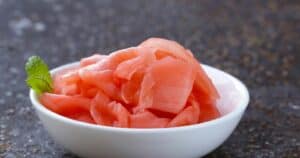Making perfect sushi starts with the rice. But how exactly do you clean and prepare sushi rice before rolling those tasty maki rolls? If you’re new to sushi making, you may be wondering about the right way to wash, cook, and season this specialty rice. Well, listen up future sushi chefs! With just a few simple steps, you can learn how to clean and prep amazing sushi rice to use in all your homemade rolls and nigiri.
First, rinse the rice. Place it in a bowl and wash it in several changes of water until the water runs clear. This removes excess starch for better rice texture. Next, soak the rinsed rice in fresh water for 30 minutes before cooking to further improve flavor and tenderness.
When ready to cook, use a 1:1 ratio of rice to water and bring to a boil. Then reduce heat and simmer for 15-20 minutes until liquid is fully absorbed. After cooking, mix the warm rice with a seasoned vinegar mixture called sushi-su. This gives the rice that subtle sweet-sour flavor and sheen.
Finally, let the seasoned rice cool and rest 10 minutes before using to make rolls or nigiri. Properly washed, cooked, and dressed sushi rice is the foundation for great homemade sushi.
Ready to become a sushi rice expert? Let’s get into the nitty-gritty details of how to perfectly clean and prep sushi rice for all your homemade Japanese cuisine needs!
Step 1: Rinsing the Rice
Washing sushi rice is a critical first step often skipped by rookie home chefs. Proper rinsing removes excess starch from the rice, resulting in the tender, glossy grains needed for sushi.
Here’s how to rinse rice for sushi:
- Place dry rice in a large bowl and cover with cool water.
- Gently swirl the rice in the water with your hands. The water will become cloudy.
- Drain the water and repeat 2-3 more times until the water runs clear.
- Drain the rinsed rice thoroughly in a mesh sieve or colander.
Rinsing washes away surface starches that would otherwise make the cooked rice gummy. Rinsing gives you fluffy, separated grains that stick together just right for shaping sushi.
Why Rinsing is Crucial
- Removes surface starches
- Prevents gummy, gluey texture
- Allows grains to cook evenly
- Enhances rice’s subtle flavors
Take the time to rinse rice thoroughly and you’ll immediately notice a difference in your sushi rice quality.
Step 2: Soaking the Rice
After rinsing, the next key step is soaking the washed rice. Letting the rinsed rice sit submerged in fresh water for 30 minutes softens the grains through hydration.
Soaked rice cooks up exceptionally tender and chewy. Skip soaking and your rice may be undercooked in the middle or unevenly textured.
Soaking Tips
- Use a 1:1 ratio of rice to water for soaking
- Let soak 30 minutes to fully hydrate grains
- Time the soaking before cooking
- No need to soak rice overnight
So take note sushi apprentices: don’t underestimate this hydrating rice rest! A half hour water bath before cooking works wonders.
Step 3: Cooking the Rice
With clean, soaked rice in hand, it’s time to start cooking. Use a heavy pot with a tight-fitting lid for best results. And resist lifting the lid during cooking—steam is key!
Perfect Rice Cooking Method
- Combine 1 cup rice with 1 cup water.
- Bring to a boil over high heat.
- Once boiling, reduce heat to low.
- Simmer covered for 15-20 minutes.
- Remove from heat and let steam with lid on 10 more minutes.
The 1:1 rice-to-water ratio gives the precise moisture level needed. Adding more water results in mushy, uneven rice.
You can also substitute 2 tablespoons of the water with sake or mirin rice wine. This adds a touch of sweetness and umami depth.
When done, the rice should be fully tender but still retain a pleasant chewy bite. Fluff with a fork or wooden paddle to release steam before dressing.
Step 4: Making the Sushi Vinegar
No sushi rice is complete without the vinegar dressing, called sushi-su or seasoning vinegar. This imparts just the right sweet-sour flavor and sheen.
Making the vinegar mixture is easy. For every cup of dry rice cooked, combine:
- 1 1⁄2 – 2 tablespoons rice vinegar
- 2 1⁄4 teaspoons sugar
- 3⁄4 teaspoon kosher salt
Heat to dissolve the sugar and salt fully. The exact amount of vinegar used depends on the variety. More gives stronger flavor.
You can also add a dash of sake for extra depth. Mix up a batch of this elixir while your rice finishes cooking.
Step 5: Dressing the Rice
Here comes the fun part—turning bland cooked rice into perfectly seasoned sushi rice.
After cooking, transfer the hot rice into a wide bowl or dish. Sprinkle or drizzle the sushi vinegar over top.
Then using a slicing motion, gently fold the vinegar into the grains. Take care not to mash or crush the rice. The idea is to coat each grain with flavor.
You’ll know it’s ready when the rice has a subtle sheen and sticks together without clumping. Enjoy your handiwork—this is sushi rice at its finest!
Extra Tips for Handling Sushi Rice
Here are a few final tips for prepping and handling sushi rice like a pro:
- Cook rice in smaller batches for best texture
- Use a wooden paddle or spatula vs. metal utensils
- Add a damp cloth over seasoned rice to keep moist
- Cool rice before assembling sushi rolls
- Use rice immediately or store sealed in fridge
Now you’re ready to transform your fluffy, vinegar-infused sushi rice into all kinds of homemade rolls, nigiri, and other Japanese delights!
Frequently Asked Questions
Does sushi rice need to be rinsed?
Yes, rinsing is a must! It removes excess starch for better rice texture. Skip rinsing and rice may be gummy.
How long should I soak sushi rice?
30 minutes is ideal. This fully hydrates the grains before cooking. No need to soak overnight.
Can I use a rice cooker for sushi rice?
Absolutely. Just rinse and soak rice first, then use a 1:1 rice-to-water ratio in the rice cooker.
Is sushi rice the same as regular rice?
No. Sushi rice is a short- or medium-grain Japanese white rice variety. The starch content differs from jasmine or basmati rice.
Does sushi rice go bad quickly?
It lasts 2-3 days sealed in the fridge. The vinegar dressing acts as a preservative. Freeze rice for longer storage.
Let’s Get Rolling!
Now you’re ready to show off your sushi skills! Proper sushi rice prep is the key to rolling, shaping, and molding incredible sushi creations. Rinse away those starches, soak the grains, and dress your rice right, and your homemade sushi is sure to impress.
What sushi rice tips or tricks can you share? Let me know in the comments!





